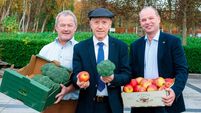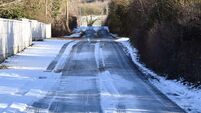Potato growers should bide their time after the coldest month
Therefore potato growers should wait for soils to warm up and take their time before deciding to plant, advises Shay Phelan of Teagasc.
Taking seed out of a sprouting house at 6-8 degrees and planting them into soils at 3-4 degrees can cause a shock to the seed which can result in “little potato disorder”.
This can often be seen in Queens and Rooster, where multiple shoots emerge from the side of the drill rather than the top, and emergence is uneven.
This will have a significant effect on overall yield, while also making weed control difficult.
To avoid the problem, keep the difference in temperature between the seed and that of the soil as close as possible.
If you have to get seed planted, then consider planting direct from the cold store.
Otherwise, wait until soil temperatures rise a few degrees.
Compaction is likely to be common in many fields, given the amount of abuse land had in 2012.
Try to avoid severely compacted areas, because these will only hold water and spread diseases such as blackleg, powdery scab, and blight.
Try to keep traffic on fields, especially on headlands, to a minimum.
Deep sub-soiling or ripping may or may not solve the problem.
It is probably better to wait until the land has dried out sufficiently before ploughing. This will reduce smearing and will increase the soil’s machinery carrying capacity.
Where compaction is unavoidable in certain parts of the field, you should consider not planting that area.
There seems to be quite an amount of rots in home saved seed, these rots — whether gangrene or dry rot — need to be removed immediately.
Check seed regularly, especially as temperatures begin to climb, because these rots will transfer to the other seed and chits in the trays or boxes.
You should therefore be very wary of planting direct from the cold store this season; it could lead to a very patchy crop, if there are a lot of rots.
Recent soil test results point to many of the traditional fertilisers not being very suitable.
Proper nutrition is the most important element of good crops, therefore if you find that compounds such as 10.10.20 or 7.6.17 leave you short in one element or over-applying another element, you should contact your supplier and investigate if you can get a specific mix or blend.
In many cases, these are much more cost effective than making one of the other compounds “fit” the field. Many companies will supply blends if the quantity ordered is large enough. They can also add in elements such as sulphur if required.
Given the year that we have experienced so far, there may also be a benefit in placing the compound this year. As soils are colder, roots may be slower to develop and to access fertiliser that has been broadcast. As a result, potatoes may be slower to emerge.
Trials have generally shown there is little difference in overall yield between the two systems, however, if the placed systems can help the crop to emerge quicker, there may well be a benefit in 2013.
You will also reduce the total amount of fertiliser applied, so costs will be reduced.









